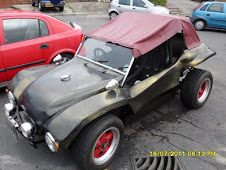12 April 2012
Two weeks ago I replaced all my convertible roof studs but two as I needed to get longer bolts that i could tap out. Unfortunately the latest revisions came out for the 2012 UK MOT a condensed two page document that has created work for all V.W owners. My existing battery location became foul to these regulations as it was not totally secure and was not covered.
 Having seen buggies with a recessed battery box in the back seat where the back seat was a long bench, I decided that it would be interesting if I could recess my battery into the rear seat area and release the space that the battery had previously occupied. I started looking for large pieces of stainless sheet .
Having seen buggies with a recessed battery box in the back seat where the back seat was a long bench, I decided that it would be interesting if I could recess my battery into the rear seat area and release the space that the battery had previously occupied. I started looking for large pieces of stainless sheet .  I measured my battery which was 205mm x 175mm x 175. I made a paper
stencil to check the size of a box dimensions which would contain the
battery and allow for the battery to be secured and the wiring to all
fit . The dimensions of the box top I arrived at was 230mm x 190 . The template I made was very useful as it allowed me to place the
template on the rear parcel area and check that it would fit. I had
already decided that I really wanted the battery in the middle of the
seat and was pleased that it appeared as if I had enough room to fit
the battery here.
I measured my battery which was 205mm x 175mm x 175. I made a paper
stencil to check the size of a box dimensions which would contain the
battery and allow for the battery to be secured and the wiring to all
fit . The dimensions of the box top I arrived at was 230mm x 190 . The template I made was very useful as it allowed me to place the
template on the rear parcel area and check that it would fit. I had
already decided that I really wanted the battery in the middle of the
seat and was pleased that it appeared as if I had enough room to fit
the battery here.I discussed this position with a friend Jon as I quickly realised that it would quite successfully free up two passenger seats. The outcome of this discussion was the question was whether the box would hit the gearbox. I measured the distance between my highest point on my gearbox near the new battery location and this was 190mm . Luckily my 80mm lift kit had given me the extra height I needed. I quickly worked out by drawing a flat layout of the box that I would need a piece of stainless steel minimum 1m x 400mm . I checked various metal stock companies and realised that the cheapest i could find this was on eBay at some £69.00 GDP. Clearly this was too expensivet and I would have to source the Stainless Steel from a different source.
 Fortunately the solution was not to far away. For several years I had been storing my Welding spares in this stainless Steel tin . It was made from 1.2mm Stainless and looked quite adequate in size to be
Fortunately the solution was not to far away. For several years I had been storing my Welding spares in this stainless Steel tin . It was made from 1.2mm Stainless and looked quite adequate in size to be  cut down . I started marking out the two opposing corners one with a floor and the other without . I used pencil to mark the outline and cut the two sections out with a 1mm angle grinder blade. The resulting parts were then chased along the edges to debur any sharp edges. The two parts were then assembled to see how they would fit together.
cut down . I started marking out the two opposing corners one with a floor and the other without . I used pencil to mark the outline and cut the two sections out with a 1mm angle grinder blade. The resulting parts were then chased along the edges to debur any sharp edges. The two parts were then assembled to see how they would fit together.  The resulting box was not bad and the two pieces fitted well clicking together to form a strong small box. I decided that I would have to bend the top mounting plates over . I used two pieces of right angle iron in a vice to clamp the stainless sheet along the line i had drawn to indicate the fold. I then struck the stainless steel with a rubber mallet to bend and fold the stainless along the angle iron at a right angle to the two irons in the vice. I repeated this for all four of the sides.
The resulting box was not bad and the two pieces fitted well clicking together to form a strong small box. I decided that I would have to bend the top mounting plates over . I used two pieces of right angle iron in a vice to clamp the stainless sheet along the line i had drawn to indicate the fold. I then struck the stainless steel with a rubber mallet to bend and fold the stainless along the angle iron at a right angle to the two irons in the vice. I repeated this for all four of the sides.I took the two box sections to Fullers Steel fabrication to have the two parts TIG welded. The resulting box was strong and gave me the dimensions that I made a template up from . This I stuck the the back centre parcel shelf of the buggy with tape . I used a Starret hole cutter to cut out the corners and used an Angle Grinder to cut between the four holes . This made a hole in the rear seat area directly over the gearbox. I drilled some holes in the box supports and made a rubber seal from an old rubber mat. The box dropped into position. I used a rubber mallet to bend the sides to fit the profile of the seat and cut the front down to sit flush on the front of the rear seat area. The battery was then placed in situ and the new battery placement could be seen for the first time.
I enclosed the battery in the old fabric cover and connected up the battery connecters and went out for a short run in the beach buggy to see if the gearbox knocked the box out of its position. My route I chose was a very bumpy one that I knew would make the suspension work hard. The trip took about 25 minutes and I was soon back in the garage happy as the box had remained in position. I looked underneath and had a good 25mm clearance

between the box and the gearbox. I removed the battery and old cover and knocked the box out of the hole. I cut two holes in the top back section of the box for the new routed cables to come through . I then fitted these with grommets another UK MOT 2012 item which seemed very obvious. I removed the old earth wiring from the chassis bolt and threaded the positive supply from the alternator out of the chassis and back into the battery box. I shortened this and fed the earth wire alongside it. The wiring had now all been removed from the back seat area and with the old battery mount removed I was able to see for the first time how the new seat areas would look.
I mounted the battery in the box and reconnected the new supply lines . It was immediately noticeable how much new space I had created on the rear seat area. I started to think about seating types and even new speaker placement positions that had also been created. I knew I had to secure the box and I also had to secure the battery to the box and create a lid to enclose the battery from the elements I was in two minds what to make this out of. I liked the shiny stainless but also felt fiberglass would look fantastic as it would match the car paint. I was very pleased with the new position and was beginning to wonder why I had never seen this done before as it looked so natural. The box was secured in position with some cut down flush Allen bolts .
I made up a stainless right angle battery holder that was the same size as my battery box I drilled two holes in each end 10mm and used two 10mm eye bolts that I purchased. I cut two holes in the box side walls to allow the eye bolts to go through . I cut one side away from the bolts to make a hook. I used this to secure the battery into the battery tray. The bolts and angle bracket fitted neatly onto the shoulder of the battery. I bolted the battery box in position and went for a run . I decided that I would try going for a longer run than I usually do. and set off to the town of battle some 20mins away. I soon found that the car ran better after it had a sudden boost on the open road. I returned to the garage happy that there must have been a blockage in the carburetors. I still however had not got the buggy over 60mph and was wondering if it would make faster speeds I also happily noted that the speedometer was accurate at 40mph & 60 mph.



























No comments:
Post a Comment